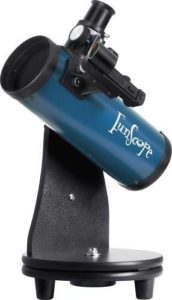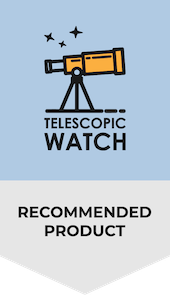The FunScope Optical Tube

The FunScope is a 76mm (3”) f/4 Newtonian with a focal length of 300mm. Unlike most quality Newtonian reflectors, which have parabolic primary mirrors, enabling them to properly focus light, the FunScope has a spherical primary mirror. This means it cannot focus light to a precise point, and the scope consequently delivers fuzzy images at any magnification above around 40x. A good 3” telescope should be usable at up to around 100x, with 60x or more being preferable for observing the Moon and planets. Unfortunately, the spherical primary mirror is simply a concession made to keep the FunScope as cheap as it is.
So too is the inability to collimate the primary mirror to ensure the sharpest possible images. If your FunScope arrives out of collimation, you either have to send it back, attempt to adjust it yourself by taking apart the scope, or just use it with even mushier images as-is.
The FunScope uses a standard 1.25” rack-and-pinion focuser to hold eyepieces, allowing it to accept pretty much any decent astronomical eyepiece. This is in contrast to many cheap, low-quality instruments that use 0.965” focusers and abysmally bad plastic eyepieces that cannot be easily replaced.
Accessories
The FunScope comes with two eyepieces: 20mm and 6mm Kellners providing 15x and 50x respectively. It also includes a 2x Barlow lens, which is all-plastic and really low in quality; it’s basically a glorified spare dust plug. The 15x provided by the 20mm Kellner is great for low-power sweeping, while the 50x with the 6mm Kellner is starting to get a bit blurry.
To aim the FunScope, there’s a red dot finder included. Cheaper copycats of the FunScope lack any sort of finder, and while the red dot is arguably overkill for aiming such a short focal length instrument its inclusion is handy.
A Moon map is included with the FunScope as well.
Mount
The Orion Funscope 76mm telescope is, as mentioned, a classic Newtonian reflector, mounted on a single arm Dobsonian styled base. You simply set it on a table, bar stool, bench, etc. and push it back and forth and up and down to aim it at a target. Adjusting the friction on the altitude (up-down) axis is easily accomplished with a small hand knob, while adjusting the azimuth requires a socket wrench or a wrench with pliers. However, if you do not want to use it as a tabletop instrument, the entire scope can be attached to a standard camera tripod instead with the ¼ 20 socket in the bottom.
Should I buy a Used FunScope?
If you can get a used FunScope for significantly less than the new price, it’s not bad. However, if you’re already shopping for used scopes, there are often much better instruments available on the used market for under £100, with larger apertures and superior optics.
Aftermarket Accessory Recommendations
The FunScope, being as inexpensive as it is, is probably not worth spending a ton of accessories on upgrading – you could just buy a better telescope with better accessories included if you spend much more. The main thing we’d recommend is some sort of medium-power eyepiece to maximise how much you can see of the Moon/planets before the image breaks down. A 9mm “gold-line” provides 33x, about the limit of what the scope can handle but enough to easily distinguish Saturn’s rings and Jupiter’s cloud belts.
What can you see?
The red dot finder of the FunScope makes it easy to aim, and the wide field of view with the included 20mm Kellner (about 3.5 degrees or 7 full Moons) makes finding almost any target a breeze. You’ll be primarily limited by the poor optics, small aperture, and light pollution conditions.
Within the solar system, the FunScope is quite limited. Mercury’s phases are a struggle. Venus shows its phases, and the Moon looks fantastic even at the relatively low magnifications the FunScope is capable of, but good luck resolving any features on Mars even when it’s close to Earth. With some effort you can see Jupiter’s cloud bands, and perhaps even the Great Red Spot, but don’t be surprised to see little more than a featureless ball with moons. Saturn’s largest moon Titan is easily visible and even at 15x you can pick out the rings, but that’s likely all you’ll see. Uranus and Neptune are not resolvable as anything more than fuzzy, vaguely bluish points of light.
The FunScope will show you a few galaxies. M31 and M33 are big enough to easily identify, being naked-eye visible under dark skies, but won’t show anything from a city or suburbs. If you can get somewhere dark, M31’s dust lane and companions, along with vague hints of the spiral arms in M33, might be visible. Many of the brighter Messier and NGC galaxies are visible with the FunScope under dark or moderately dark skies, including the Virgo Cluster, but 15x won’t yield any detail and pumping up the power will result in you running out of sharpness and image brightness very quickly.
Globular clusters are easily spotted in the FunScope, and are clearly not stars even at 15x, but don’t expect to be able to resolve them with the FunScope – or indeed any scope below 5-6” in aperture. Planetary nebulae are basically out of reach of the FunScope due to its small aperture and inability to perform at magnifications over 30-40x.
Large nebulae like M42 and M8 look great through the FunScope, especially under dark skies. And lastly, open star clusters are probably the most rewarding of all. Their large angular size, brightness, and their relative abundance throughout the sky make them a great match for the FirstScope’s capabilities – particularly M35, the Pleiades, the Beehive, and the Double Cluster.


